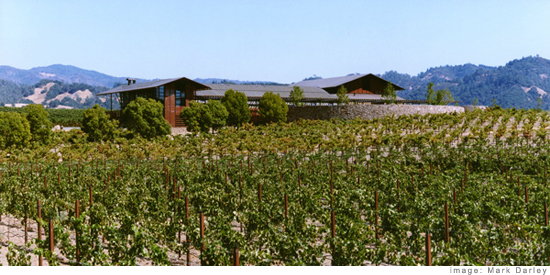Sustainable Sonoma: wine country architecture
Autumn is a beautiful time of year in Northern California, and Stryker Sonoma is a favorite travel destination during the fall season. The picturesque location and beautiful architecture make for a quintessential wine country experience, while serving as a great example of sustainable architecture and timeless green design...
This beautiful, family-owned winery on a 32-acre site in Geyserville, California is noted for its red wine offerings as well as its stunning surroundings and spectacular views, as seen in the view from the tasting room above.
The architectural design reflects Stryker Sonoma's 'bold but thoughtful' philosophy and expresses this spirit with a distinctly contemporary aesthetic that references the rural characteristics of the site to create continuity between the natural and built landscapes.
The design also conveys the the winemaking processes that occur within it through the thoughtful application of local materials, the incorporation of varying levels of visual transparency, and an environmentally-sensitive site layout.
Visitors are given the opportunity to experience the architecture and the functions it houses as they travel through the entry arbor and along the path that rises above the vineyards, as the concrete walls of the fermentation rooms and cellar give way to the glass-enclosed tasting room at the end of the bridge- an intimate space that provides the perfect setting for both indoor and outdoor gatherings.
Designed by Sonoma-based firm Nielsen : Schuh Architects, the winery building incorporates sustainable strategies and passive design concepts at the 12,600 square foot working facility. An environmentally-responsive and site-inspired design serves the needs of the program with minimal development impact to the existing vineyards.
The grade of the site was not significantly disturbed during construction, with walls, roads and the buildings' footprints following the contours of the land. Low walls of local stone connect the visitor spaces to the natural setting below, and they extend into the vineyards to further underscore the relationship to the landscape.
The interior layout utilizes the gently sloping topography efficiently, with the wine cellars located below the tasting room at the main level to take advantage of the thermal properties of below-grade construction, depicted in the elevation drawings above. (courtesy of Nielsen:Schuh)
The buildings are oriented for passive ventilation from the prevailing winds and the forms respond to the elements by providing shade with deep roof overhangs where necessary, while concrete floor and wall systems act as thermal mass to absorb heat and maintain consistent interior temperatures.
Precast concrete louvers provide an architectural language that serves a number of purposes: the color is derived from the natural stone used at the terrace walls, while the form mimics the linear nature of the vineyard. They also act as screening to provide shade at both exterior and interior spaces, while openings in the screens frame views and transition into guardrails at certain locations.
An innovative, integrated design that responds thoughtfully to its gorgeous wine country site, the project's aesthetic represents both form and function beautifully and creates a meaningful connection to the land, its purpose and the relationships between the two, making Stryker Sonoma a unique destination, and the perfect place to enjoy a glass of wine, incredible views, and timeless architecture. For more information, visit nielsenschuh.com.
Cheers!







